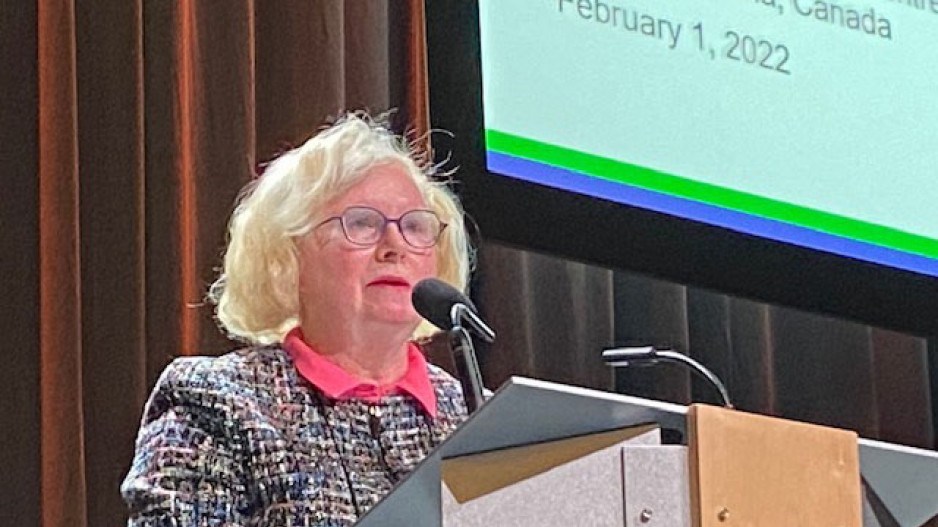During a Q&A at the Association of Mineral Exploration (AME) Roundup Tuesday, Douglas Porter, chief economist for BMO Financial Group, was asked what commodity he thought would be a top performer, gold or copper?
Porter answered: “I’d go with natural gas as number one."
In a room filled with gold-bugs, it may not have gotten as big a laugh as it should have. He went on to say that, if he had to choose between gold and copper, he said he thought copper has "the best medium-term potential."
But when it comes to base metals in general, Porter said he was "not in the supercycle camp.”
Porter was among the speakers at a session on financial and commodities markets. Also speaking at the session was Patricia Mohr, a former Scotiabank commodities guru, who is in the supercycle camp.
“I do expect a super-cycle for copper,” said Mohr, who is now editor for a Capitalight Research newsletter, Critical Metals report.
In fact, she predicts strong demand and prices for several critical metals needed for the energy transition – copper, nickel, lithium and rare earths – all of which is good for Canada.
In 2020, Mohr made some bullish predictions for copper, and since then copper has broken records, hitting US$4.88 per pound in May 2021. Scotiabank is now predicting copper prices to be in the US$4.25 per pound range into 2023, before hitting US$5 per pound by 2025.
Mohr said the drive towards electric vehicle adoption alone promises to drive the demand for copper to new heights. Add in renewable energy, and the demand for copper may well outstrip supply at some point.
The International Energy Agency (IEA) has expressed concern that there will not be enough critical metals to meet the demand of the energy transition.
“I would tell you, looking at the outlook in some detail, I would agree that the world should be concerned, that in fact there will not be enough metals available,” Mohr said.
As part of her research for the new Critical Metals report, Mohr has focused on copper, nickel, lithium and three rare earths or battery and magnet metals – neodymium, praseodymium and dysprosium.
Since 2020, 44 national governments have committed to net zero emissions by 2050, Mohr noted, which necessarily will mean a massive switch to electric vehicles, if targets are to be met.
"These countries represent 70% of global GDP,” Mohr pointed out.
She said China had set a target of having 20% of commercial and passenger vehicles being electric by 2025.
“I think they could actually meet that target this year,” Mohr said.
Renewable energy uses twice the amount of copper as traditional power, Mohr said. Both India and China are planning massive installations of renewable energy, which will result in a huge demand for copper.
New copper mines coming online, including the Teck Resources (TSX:TECK.B) Quebrada Blanca Phase 2, will help meet some of the increasing demand for copper in the short term.
“However, beginning around 2025, I think copper is going to jump up to another level – about $5, maybe even higher,” Mohr said. “What you’re going to see is a big decline in actual world production from around 2026 onwards, in the midst of a very strong demand growth around the world.
“So I think you’re going to have a very strong performance from copper medium-term. That’s very important, of course, for British Columbia.”
B.C. is Canada’s largest producer of copper.
The prospects are also very good for nickel, driven by increased demand in stainless steel and batteries. Mohr said there are “critically low” inventories in China.
New production coming online may mute prices in 2023, but longer term expects the demand for nickel to be very strong.
“The global decarbonization will lead to a huge opportunity for Canada’s nickel industry,” Mohr said.
She said she is aware of five proposed nickel mine projects in Canada – two of them in B.C.
In the area of rare earths, there is now one light rare earth mine in Canada, in the Northwest Territories. One rare earth deposit has identified in B.C. for possible development – the Wicheeda property.
As for lithium – a critical component of EV batteries -- Mohr sees an increasing demand for that as well, and thinks the best opportunities for lithium production is in Alberta, where lithium can be extracted from the brines of old oil and gas wells.
“I think Alberta actually could emerge as one of the world’s biggest lithium producers from the old aquifers,” Mohr said.




